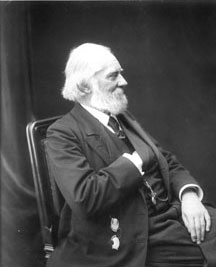<Back to Index>
- Sociologist Norbert Elias, 1897
- Composer Theodor Leschetizky, 1830
- Dictator of Ghana Jerry John Rawlings, 1947
PAGE SPONSOR

Theodor Leschetizky (22 June 1830 – 14 November 1915) was a Polish pianist, professor and composer.
Theodor Leschetizky was born on the estate of the family of Count Potocki in Łańcut. His father was a gifted pianist and music teacher of Viennese birth. His mother Therèse (von) Ulmann was a gifted singer of German origin. Leschetizky's father gave him his first piano lessons and then took him to Vienna to study with Czerny. At age eleven he performed a Czerny piano concerto in Lemberg (near Łańcut), with Franz Xaver Wolfgang Mozart (the son of Wolfgang Amadeus Mozart) conducting. At the age of fourteen, he started to tutor his first pupils. By the age of eighteen he was a well known virtuoso in Vienna and beyond. His composition teacher was Simon Sechter, subsequently the teacher of Anton Bruckner.
At the invitation of his friend Anton Rubinstein he went to St. Petersburg to teach in the court of the Grand Duchess Helen. Remaining there from 1852 to 1877, he was one of the founders of the St. Petersburg Conservatory of Music in 1862. While in Russia he married one of his most famous pupils, Anna Yesipova (the second of his four wives), and had two children (one of them Robert Leschetizky).
In
1878 he returned to Vienna and began teaching there, creating one of
the most eminent private piano studios in history, besides Franz Liszt in Weimar. He taught thousands of students, in the Weimarerstraße (formerly the Carl Ludwigstraße) XIX. Bezirk Wien, Vienna.
They came from all over the world, many from the United States.
Leschetizky taught until the age of 85, leaving for Dresden in 1915,
where he died that year. He was survived by a son, Robert (Dresden), whose family returned to Bad Ischl after
his death. His descendants still live in Bad Ischl and there is a
Leschetizky Villa at the Leschetizky Straβe, the summer resort, where
Theodor Leschetizky often vacationed with his friend Johannes Brahms. Leschetizky
had a granddaughter, Ilse Leschetizky (1910 - 1997), who was a
distinguished pianist and teacher. One of her daughters, Margret
Tautschnig, continues the Leschetizky tradition with the Leschetizky Verein Ősterreich in Bad Ischl. This organisation was co-founded by the Belgian pianist Peter Ritzen. Among
his celebrated Vorbereiter (assistants who prepared students to play
for him) were Katherine Goodson, Annette Hullah, Marie Prentner, and
Malwine Brée, author of The Leschetizky Method (a title which he approved, while stating that there "was no method!"). The list of virtuoso concert artists he trained includes Anna Yesipova, Ignaz Friedman, Ignacy Jan Paderewski, Artur Schnabel, Mark Hambourg, Alexander Brailowsky, Benno Moiseiwitsch, and Mieczysław Horszowski. Perhaps
the secret of his successful teaching was that he worked with each
student's personality and technical abilities in an individual way. His
famous weekly classes provided his students the opportunity to try out
their pieces prior to public performances before a discerning audience
of their fellow students and invited guests. A humourous probable allusion to Leschetizky occurs in the "Stella in Oxford" Chapter (Book Three, Chapter 10) of Compton Mackenzie's 1913 - 1914 novel Sinister Street, where there is mentioned a notable teacher of the piano in Vienna "with a perfectly impossible name beginning with L". Until
his death, Leschetizky espoused a philosophy of music making and
enjoying life to the fullest, captured in one of his most famous
sayings (translated from the German): Theodor
Leschetizky possessed a distinct talent for composition. He wrote over
one hundred characteristic piano pieces, two operas: Die Bruder von San Marco and Die Erste Falte, thirteen songs, and a one - movement piano concerto. Opus numbers were given to 49 works. Although
his piano pieces are primarily smaller works in the genre of salon
music, they display an expressive lyric gift while exploiting the
piano's capabilities to great effect. Most of Leschetizky's music has
been out of print since the early twentieth century, with the exception
of the Andante Finale, Op. 13 (a paraphrase for piano left hand on the famous sextet from the opera Lucia di Lammermoor by Donizetti); and Les deux alouettes, Op. 2, No. 1.